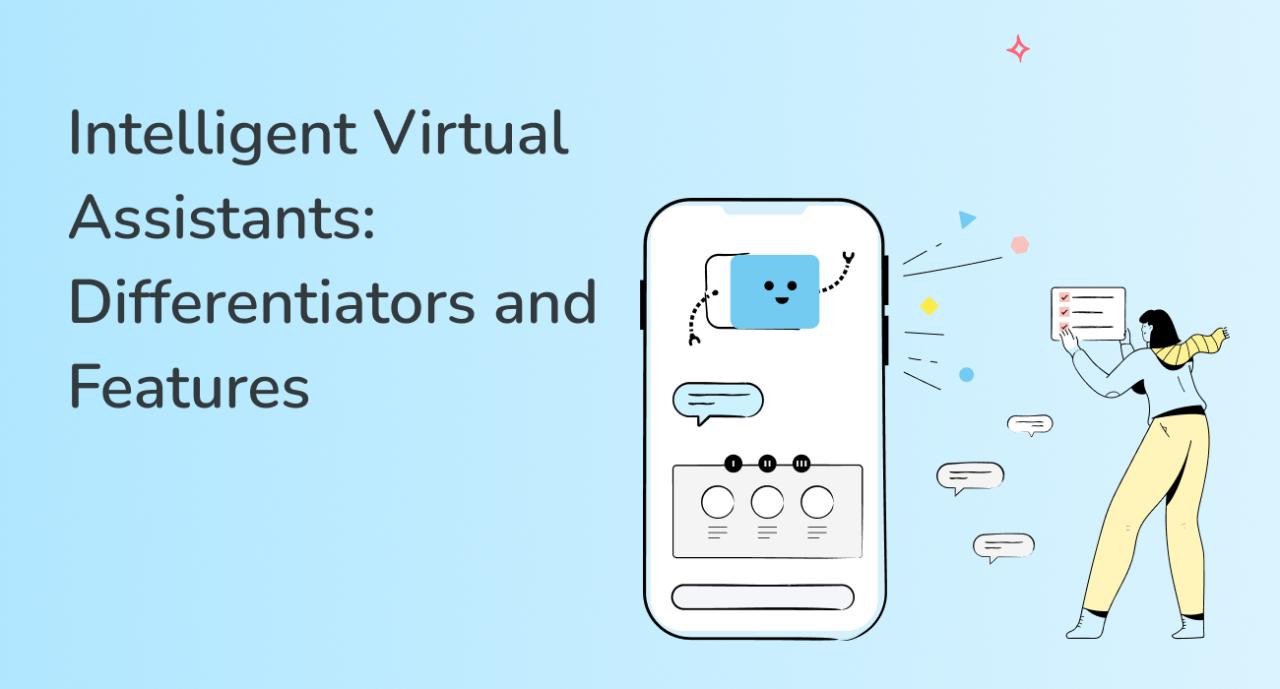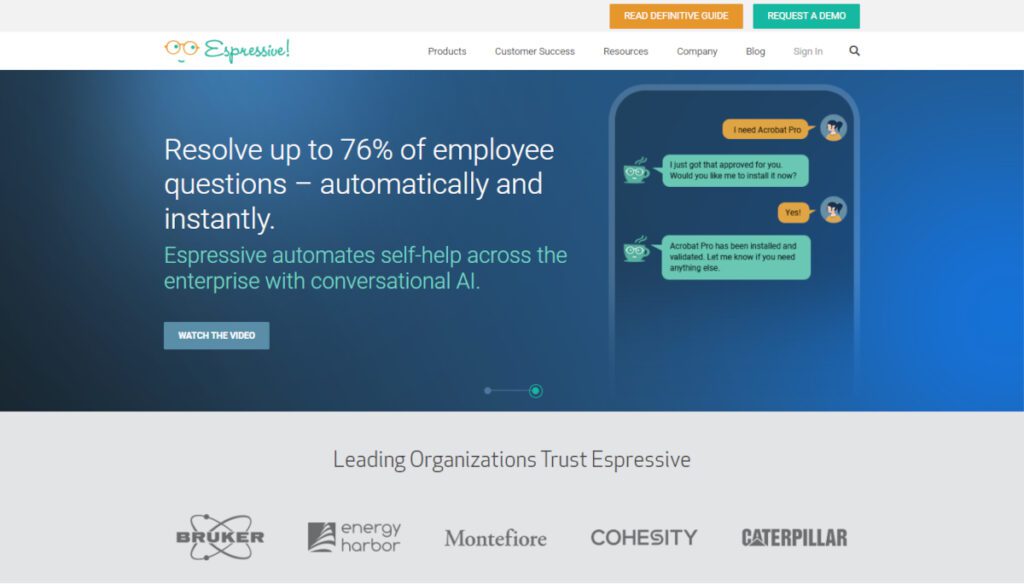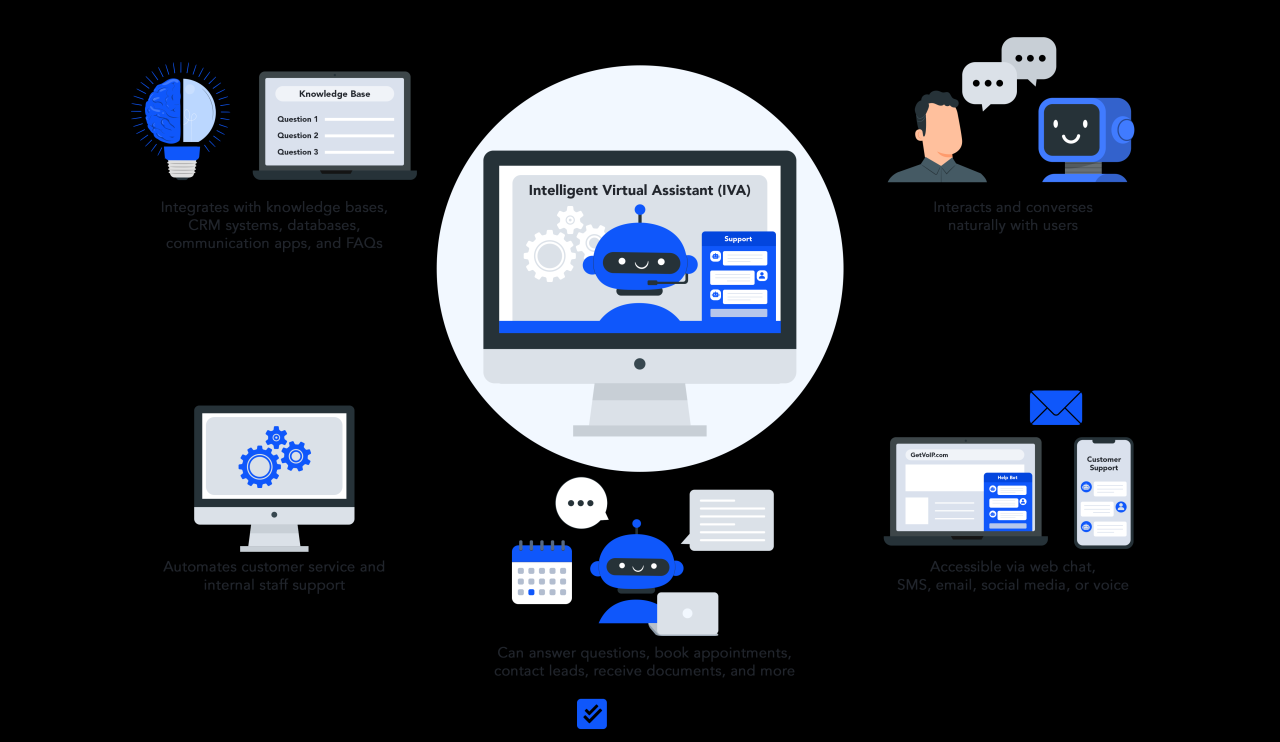Intelligent virtual assistants for CRM are revolutionizing customer relationship management. These advanced systems, far surpassing traditional chatbots, leverage natural language processing (NLP) and machine learning to automate tasks, personalize interactions, and dramatically improve efficiency. This exploration delves into the capabilities, implementation, and impact of IVAs on various industries, highlighting their potential to transform CRM strategies and enhance customer experiences.
From streamlining lead management and automating repetitive processes to providing 24/7 customer support and generating valuable data-driven insights, IVAs offer a multitude of benefits. This examination will cover key features, integration best practices, and potential challenges, ultimately showcasing how IVAs are shaping the future of CRM.
Defining Intelligent Virtual Assistants (IVAs) in CRM
Intelligent Virtual Assistants (IVAs) are transforming Customer Relationship Management (CRM) systems by automating tasks, improving customer service, and providing valuable insights. They represent a significant advancement over traditional chatbots, offering more sophisticated capabilities and a more seamless integration within the CRM workflow.
Core Functionalities of IVAs in CRM
IVAs within a CRM system perform a wide range of functions designed to streamline operations and enhance customer interactions. These include lead qualification and routing, appointment scheduling, answering frequently asked questions, providing product information, processing orders, and managing customer support tickets. They leverage natural language processing (NLP) and machine learning (ML) to understand and respond to customer requests accurately and efficiently, even handling complex queries.
Beyond simple responses, IVAs can access and update CRM data in real-time, ensuring information consistency and providing a personalized experience for each customer.
Differences Between IVAs and Traditional Chatbots in CRM
While both IVAs and traditional chatbots aim to automate interactions, IVAs possess significantly enhanced capabilities. Traditional chatbots often rely on pre-programmed rules and decision trees, limiting their ability to handle nuanced or unexpected queries. In contrast, IVAs utilize advanced AI techniques, including NLP and ML, to understand context, interpret natural language, and learn from past interactions. This allows IVAs to provide more accurate and personalized responses, adapt to changing customer needs, and proactively offer assistance.
Furthermore, IVAs typically integrate more deeply with CRM systems, accessing and updating data in real-time, whereas traditional chatbots may operate more independently.
Benefits of Integrating IVAs into CRM Workflows
Integrating IVAs into CRM workflows offers numerous advantages. Improved customer service is a key benefit, with IVAs providing immediate support and personalized interactions. Automation of repetitive tasks frees up human agents to focus on more complex issues, leading to increased efficiency and productivity. The ability to analyze customer interactions provides valuable insights into customer preferences and behavior, informing marketing and sales strategies.
Finally, IVAs can contribute to cost savings by reducing the need for a large customer service team and improving operational efficiency.
Real-World Applications of IVAs in CRM Across Various Industries
IVAs find applications across diverse industries. In e-commerce, they handle order processing, track shipments, and answer product inquiries. In the financial services sector, they assist with account inquiries, fraud detection, and onboarding new customers. Healthcare providers utilize IVAs to schedule appointments, manage patient records, and answer medical questions. The travel industry leverages IVAs for booking flights and hotels, managing itineraries, and providing travel advice.
Each application demonstrates the versatility and adaptability of IVAs to meet the specific needs of different industries.
Comparison of Three Different IVAs for CRM
| Feature | IVA A | IVA B | IVA C |
|---|---|---|---|
| Natural Language Processing | Advanced NLP with sentiment analysis | Basic NLP, limited context understanding | Mid-range NLP, good context awareness |
| Integration Capabilities | Seamless integration with major CRM platforms | Limited integration options, custom development often required | Integrates with popular CRM platforms, some customization may be needed |
| Pricing | Subscription-based, tiered pricing | One-time purchase, limited features | Subscription-based, competitive pricing |
| Machine Learning Capabilities | Self-learning, improves accuracy over time | Limited machine learning capabilities | Moderate machine learning, improves over time |
IVA Capabilities and Features for Enhanced CRM

Intelligent Virtual Assistants (IVAs) are revolutionizing Customer Relationship Management (CRM) systems, offering significant improvements in efficiency and customer satisfaction. By automating tasks, providing instant support, and analyzing customer data, IVAs empower businesses to deliver personalized experiences and streamline their operations. This section will explore the key capabilities and features of IVAs within the context of enhanced CRM functionality.
Improved Customer Service Interactions
IVAs dramatically enhance customer service interactions by providing 24/7 availability, immediate responses, and personalized support. Customers can receive assistance with common inquiries, such as order tracking, billing questions, or technical support, without needing to wait for a human agent. This instant access to information reduces customer frustration and improves overall satisfaction. Furthermore, IVAs can seamlessly transfer complex issues to human agents, providing a smooth and efficient transition.
The ability to handle multiple customer interactions simultaneously also significantly increases operational efficiency. For example, a large e-commerce company might use an IVA to handle thousands of simple order tracking requests concurrently, freeing up human agents to focus on more complex problems.
The Role of Natural Language Processing in IVA-powered CRM
Natural Language Processing (NLP) is the backbone of effective IVAs in CRM. NLP allows IVAs to understand and interpret human language, enabling them to engage in meaningful conversations with customers. This includes understanding the intent behind customer requests, extracting key information from their queries, and formulating appropriate responses. Advanced NLP techniques, such as sentiment analysis, can even detect the customer’s emotional state, allowing the IVA to tailor its response accordingly.
For instance, if a customer expresses frustration, the IVA might offer a more empathetic response and escalate the issue to a human agent more quickly. This capability significantly improves customer experience and strengthens the customer-business relationship.
Key Features of an Effective IVA for CRM Lead Management
Effective IVAs for CRM lead management offer several key features. They can automatically qualify leads based on predefined criteria, such as company size, industry, or budget. This automated qualification process saves valuable time and resources for sales teams. Additionally, IVAs can prioritize leads based on their potential value, ensuring that sales representatives focus their efforts on the most promising opportunities.
They can also schedule appointments, send follow-up emails, and provide sales representatives with relevant information about each lead, thereby optimizing the entire sales process. For example, an IVA might identify a high-value lead based on website activity and automatically notify the appropriate sales representative, complete with a summary of the lead’s engagement.
Automating Repetitive Tasks within the CRM
IVAs excel at automating repetitive and time-consuming tasks within the CRM system, freeing up human employees to focus on higher-value activities. These tasks can include data entry, appointment scheduling, email marketing campaigns, and report generation. By automating these processes, IVAs significantly increase efficiency and reduce the risk of human error. For instance, an IVA could automatically update customer information after a successful purchase, reducing the workload on administrative staff and ensuring data accuracy.
This increased efficiency translates directly to cost savings and improved productivity.
Flowchart: IVA Handling a Customer Inquiry
The following flowchart illustrates the process of an IVA handling a customer inquiry within a CRM system:[Imagine a flowchart here. The flowchart would begin with a “Customer Inquiry” box. This would lead to a “Natural Language Processing (NLP) Analysis” box, determining the intent of the inquiry. This would then branch into multiple boxes depending on the inquiry type: “Simple Inquiry (e.g., order tracking)” leading to a “Retrieve Information from CRM” box and then an “Automated Response” box; “Complex Inquiry” leading to a “Human Agent Transfer” box; and “Unrecognized Inquiry” leading to a “Request Clarification” box.
All branches eventually converge at a “End of Interaction” box. The flowchart visually represents the decision-making process of the IVA in handling different customer inquiries.]
Integration and Implementation of IVAs in CRM Systems
Successfully integrating an Intelligent Virtual Assistant (IVA) into your CRM system requires careful planning and execution. The process involves a blend of technical expertise, strategic alignment with business goals, and a thorough understanding of your existing CRM infrastructure. A well-integrated IVA can significantly improve efficiency, customer satisfaction, and overall operational effectiveness.
Best Practices for Integrating IVAs with Existing CRM Platforms
Choosing the right integration method is crucial for a smooth implementation. Consider factors like your CRM’s API capabilities, the IVA’s architecture, and your team’s technical skills. Prioritize a method that minimizes disruption to existing workflows and ensures seamless data flow between the IVA and your CRM. Thorough testing throughout the integration process is paramount to identify and resolve any potential issues before full deployment.
Regularly review and update the integration to adapt to evolving CRM features and IVA capabilities. This proactive approach ensures long-term stability and optimal performance.
Technical Considerations for Implementing IVAs in a CRM Environment, Intelligent virtual assistants for CRM
Several technical aspects demand attention during IVA implementation. Data security and privacy are paramount; robust authentication and authorization mechanisms are essential to protect sensitive customer information. Scalability is another key factor; the system should be able to handle increasing volumes of interactions without performance degradation. Real-time data synchronization between the IVA and CRM is crucial for maintaining data consistency and providing accurate information to both agents and customers.
API compatibility between the IVA and CRM is vital, ensuring seamless data exchange. Careful consideration should also be given to the IVA’s natural language processing (NLP) capabilities to ensure accurate interpretation of user requests. For instance, the IVA needs to be trained on the specific terminology and phrasing used by your customers and agents.
Potential Challenges Associated with IVA Integration and Proposed Solutions
Data migration can present challenges, particularly when dealing with large datasets. A phased approach, migrating data incrementally, can mitigate risks. Integration complexity can arise from differences in the architectures of the IVA and CRM systems. Employing experienced integration specialists can overcome this. Maintaining data consistency between the IVA and CRM can be difficult.
Regular data reconciliation processes are necessary to address this. Ensuring seamless user experience requires careful design and testing of the IVA’s interface. User acceptance testing (UAT) involving representative users can reveal usability issues early on. Finally, managing and updating the IVA’s knowledge base requires ongoing effort. Establishing a clear process for knowledge base management and regular updates is vital for maintaining IVA accuracy and effectiveness.
Comparison of Different Integration Methods for IVAs with CRM Systems
Several integration methods exist, each with its strengths and weaknesses. Direct API integration offers tight coupling and real-time data synchronization but requires significant development effort. Cloud-based integration platforms provide a more flexible and scalable solution but may introduce latency. Pre-built connectors, if available, offer a quick and easy integration but may lack customization options. The optimal method depends on the specific needs of the organization, considering factors such as budget, technical expertise, and desired level of customization.
For example, a company with a large, complex CRM system and a dedicated IT team might opt for direct API integration, while a smaller company might prefer a cloud-based platform or pre-built connector for faster implementation.
Step-by-Step Guide on the Implementation Process of an IVA into a CRM
The implementation process typically involves several key steps. First, define clear objectives and scope for the IVA integration. Next, select an appropriate IVA platform and integration method. Then, design the IVA’s functionality and conversational flows, including the training data for NLP. Following this, implement the integration, ensuring data security and scalability.
After that, conduct thorough testing to identify and resolve any issues. Finally, deploy the IVA and monitor its performance, making adjustments as needed. Each step should be documented thoroughly to ensure a smooth and efficient implementation process and facilitate future maintenance and upgrades. For instance, a detailed documentation of the conversational flows will be essential for future modifications and training data updates.
Impact and Future Trends of IVAs in CRM

Intelligent Virtual Assistants (IVAs) are rapidly transforming the Customer Relationship Management (CRM) landscape, impacting various aspects of business operations and customer interactions. Their influence extends beyond simple automation, offering significant potential for enhanced efficiency, improved customer experiences, and data-driven decision-making. This section will explore the profound impact of IVAs on customer satisfaction, sales conversion, and the overall future of CRM.IVAs are poised to revolutionize the way businesses interact with their customers and manage their relationships.
Their ability to handle routine tasks, provide instant support, and personalize interactions is leading to significant improvements across the board.
Impact of IVAs on Customer Satisfaction and Loyalty
The deployment of IVAs in CRM directly contributes to higher customer satisfaction and loyalty. By providing 24/7 availability, immediate responses to queries, and personalized service, IVAs alleviate common customer frustrations associated with long wait times and inefficient support channels. This consistent, readily available support fosters a sense of value and appreciation, ultimately increasing customer loyalty. For example, a company using an IVA to handle basic order tracking and shipping updates can significantly reduce the number of customer service calls, freeing up human agents to focus on more complex issues.
This faster resolution time and improved accessibility translate directly into increased customer satisfaction.
Impact of IVAs on Sales Conversion Rates
IVAs can significantly improve sales conversion rates within a CRM system. By providing personalized product recommendations based on customer data, proactively addressing customer concerns, and guiding them through the sales funnel, IVAs enhance the overall customer journey. A well-integrated IVA can identify potential sales opportunities, nurture leads, and even qualify prospects, leading to a higher conversion rate. For instance, an e-commerce company using an IVA to guide customers through the checkout process, answer product questions in real-time, and offer personalized discounts can see a substantial increase in completed purchases.
Future Developments and Trends in IVA Technology for CRM
The future of IVAs in CRM is marked by continuous innovation and integration of advanced technologies. We can expect to see further advancements in:
- Enhanced Natural Language Processing (NLP): IVAs will become even more adept at understanding and responding to complex customer queries, leading to more natural and human-like interactions.
- Increased Personalization: Leveraging AI and machine learning, IVAs will personalize interactions to an unprecedented degree, offering tailored recommendations and support based on individual customer preferences and behaviors. Think of an IVA that remembers a customer’s past purchases and proactively suggests complementary products.
- Proactive Support: IVAs will move beyond reactive support, anticipating customer needs and proactively offering assistance before issues arise. For example, an IVA could alert a customer about a potential shipping delay before they even notice it themselves.
- Integration with other CRM tools: Seamless integration with other CRM tools, such as marketing automation and sales force automation platforms, will further streamline business processes and improve efficiency.
- Multi-channel support: IVAs will support interaction across multiple channels, including voice, chat, email, and social media, providing a consistent customer experience regardless of the communication method used.
Ethical Considerations Surrounding the Use of IVAs in CRM
The use of IVAs in CRM raises important ethical considerations, primarily concerning data privacy and transparency. It is crucial to ensure that customer data is handled responsibly and ethically, complying with all relevant regulations such as GDPR and CCPA. Transparency about the use of IVAs in customer interactions is also vital, allowing customers to understand how their data is being used and ensuring they have control over their privacy.
Companies must establish clear guidelines and policies to address these ethical considerations and maintain customer trust.
Contribution of IVAs to Data-Driven Decision-Making in CRM
IVAs generate a wealth of valuable data that can be leveraged for data-driven decision-making in CRM. This data can provide insights into customer behavior, preferences, and needs, informing strategic decisions related to product development, marketing campaigns, and customer service strategies.
- Identifying Customer Pain Points: Analyzing the types of questions and issues frequently raised by customers through the IVA can highlight areas where improvements are needed in products or services.
- Optimizing Sales Processes: Tracking the effectiveness of different IVA interactions throughout the sales funnel can reveal areas for optimization, such as improving the onboarding process or addressing specific customer objections more effectively.
- Personalizing Marketing Campaigns: Data on customer preferences and behaviors collected by the IVA can be used to segment audiences and personalize marketing messages, leading to higher engagement and conversion rates.
- Improving Customer Service Efficiency: Analyzing the volume and types of customer interactions handled by the IVA can help optimize staffing levels and resource allocation for human agents.
Case Studies and Examples of Successful IVA Implementations in CRM: Intelligent Virtual Assistants For CRM

This section details three successful implementations of Intelligent Virtual Assistants (IVAs) in different CRM systems, highlighting the challenges overcome, solutions employed, and measurable results achieved. These case studies illustrate the tangible benefits of IVA integration and provide insights into potential ROI across various industries.
Case Study 1: Improved Lead Qualification at a Tech Startup
This rapidly growing tech startup utilized an IVA integrated with Salesforce to automate lead qualification. Prior to IVA implementation, sales representatives spent significant time on initial lead screening, resulting in bottlenecks and decreased efficiency. The IVA was programmed to collect essential information from inbound leads via a conversational interface, qualifying them based on pre-defined criteria (e.g., company size, industry, budget).
The challenge was integrating the IVA seamlessly with Salesforce to automatically update lead records with the gathered information. The solution involved custom API development to ensure real-time data synchronization between the IVA and Salesforce. Measurable results included a 40% reduction in lead qualification time, a 25% increase in qualified leads, and a 15% improvement in sales conversion rates.
Case Study 2: Enhanced Customer Service at a Large Financial Institution
A major financial institution integrated an IVA with its Microsoft Dynamics 365 CRM to enhance customer service and reduce call center wait times. The primary challenge was handling the diverse range of customer inquiries while maintaining accuracy and consistency. The IVA was trained on a vast knowledge base of frequently asked questions, account information, and product details. The solution included natural language processing (NLP) and machine learning (ML) algorithms to understand customer requests and provide appropriate responses or route calls to the relevant human agent.
The measurable results showed a 30% decrease in average call handling time, a 20% reduction in call center costs, and a 10% increase in customer satisfaction scores.
Case Study 3: Streamlined Sales Processes at a Global Retail Company
A global retail company implemented an IVA within its SAP CRM system to streamline sales processes and improve sales representative productivity. The main challenge was integrating the IVA with various internal systems, including inventory management and order processing. The IVA was designed to assist sales representatives with tasks such as order placement, inventory checking, and customer account information retrieval. The solution involved a robust API integration strategy that connected the IVA to multiple back-end systems.
Measurable results included a 15% increase in sales representative productivity, a 10% reduction in order processing errors, and a 5% improvement in overall sales revenue.
IVA User Interface Example within a CRM Dashboard
Imagine a CRM dashboard displaying customer information. To the right, a chat window features a conversational interface with the IVA. The user can type questions or requests, such as “Show me all open opportunities for Acme Corp,” or “What’s the current inventory level for product X?”. The IVA responds in real-time, displaying relevant information directly within the chat window or updating the dashboard accordingly.
The interface is clean, intuitive, and seamlessly integrated into the existing CRM workflow. This allows users to access crucial information and complete tasks efficiently without switching between applications.
Return on Investment (ROI) of IVA Implementations Across Industries
While precise ROI figures vary widely depending on factors like implementation complexity, industry, and specific business needs, general trends can be observed. In customer service-intensive industries like financial services and telecommunications, IVAs often demonstrate rapid ROI through reduced labor costs and improved customer satisfaction. For sales-focused industries like retail and technology, the ROI is often realized through increased sales productivity and improved lead conversion rates.
Manufacturing and logistics companies can see benefits in streamlined operations and reduced errors. Quantifying ROI requires careful consideration of initial investment costs (software, integration, training), operational cost savings (reduced labor, improved efficiency), and revenue generation (increased sales, improved customer retention). A comprehensive cost-benefit analysis is crucial for accurate ROI calculation.
The integration of intelligent virtual assistants into CRM systems represents a significant advancement in customer relationship management. By automating tasks, personalizing interactions, and providing valuable data-driven insights, IVAs offer businesses a powerful tool to enhance customer satisfaction, boost sales conversion rates, and achieve a significant return on investment. As IVA technology continues to evolve, its impact on CRM strategies will only grow, promising a future of more efficient, personalized, and data-driven customer engagement.
Common Queries
What is the cost of implementing an IVA in my CRM?
The cost varies greatly depending on the chosen IVA, its features, the complexity of integration, and ongoing maintenance. Expect a range from relatively low costs for simpler solutions to substantial investments for highly customized, enterprise-level systems.
How secure is data handled by IVAs in CRM?
Data security is paramount. Reputable IVA providers employ robust security measures, including encryption and access controls, to protect sensitive customer information. It’s crucial to choose a provider with a strong security track record and compliance with relevant data privacy regulations.
Can IVAs integrate with all CRM platforms?
While many IVAs offer broad compatibility, seamless integration isn’t guaranteed across all platforms. Compatibility should be a key consideration when selecting an IVA, and some may require custom development for optimal integration with specific CRM systems.
What training is required to use an IVA effectively?
Training needs vary depending on the IVA’s complexity and your team’s technical skills. Some systems are user-friendly and require minimal training, while others might necessitate more in-depth instruction on configuration, customization, and data analysis.
